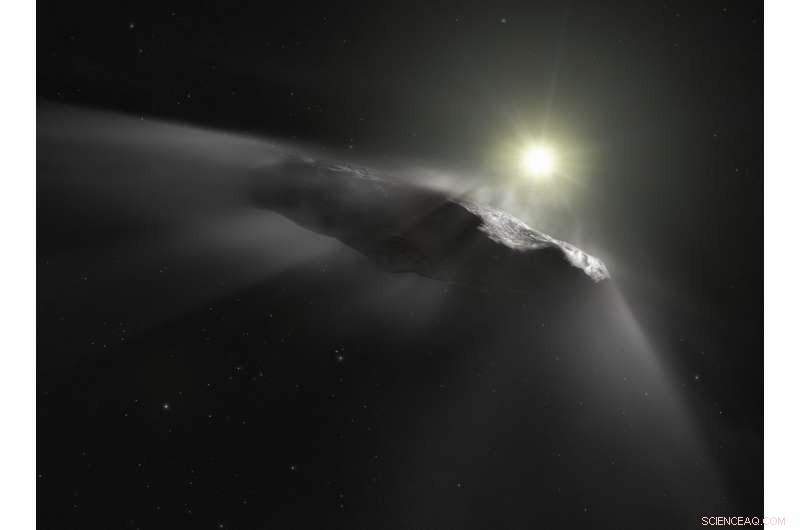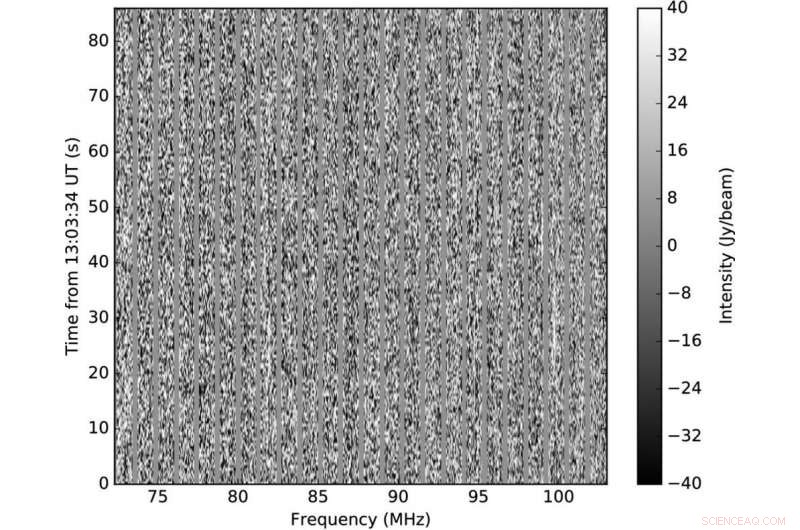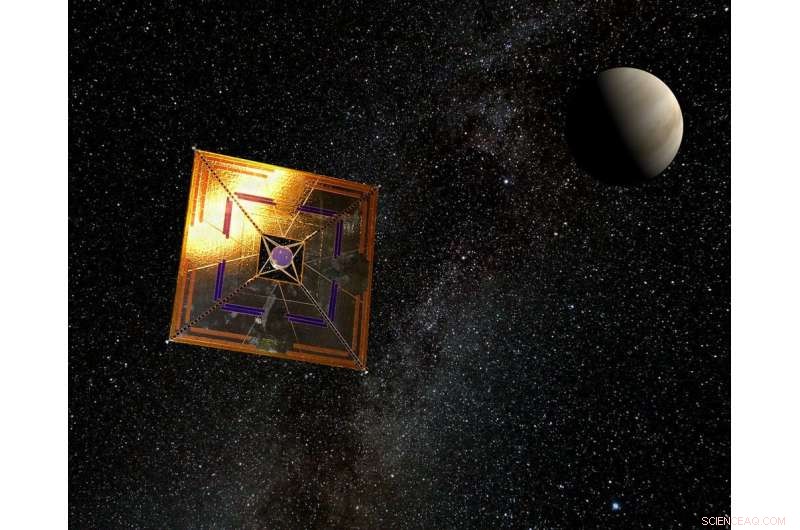
Une vue d'artiste de 'Oumuamua, le premier objet interstellaire découvert dans le système solaire. ESA/Hubble, Nasa, ESO, M. Kornmesser, CC PAR
En tant qu'astrophysicien, probablement la question la plus courante qu'on me pose est :« Sommes-nous seuls dans l'univers et existe-t-il des extraterrestres ?
Il n'y a aucun doute :les gens aiment penser et parler des extraterrestres. D'où, des histoires sur la recherche d'intelligence extraterrestre sont reprises et rapportées avec enthousiasme dans les médias.
Mais ce qui se trouve vraiment au cœur de ce sujet compliqué et populaire, ce sont les preuves - la nature de toute preuve de vie extraterrestre, comment nous considérons et respectons ces preuves, et comment cela est communiqué au public.
Cela n'est nulle part plus important que dans la couverture des études scientifiques d'un objet mystérieux - 'Oumuamua - qui a été récemment découvert en passant par notre système solaire. Par exemple, deux publications dans deux revues respectées à comité de lecture ont suscité des réactions très différentes.
Bonjour 'Oumuamua
'Oumuamua, signifiant éclaireur ou messager en hawaïen, est le nom donné au premier objet interstellaire détecté à visiter notre système solaire. A la découverte l'année dernière, 'Oumuamua a été classé comme une comète, mais cela a été retiré plus tard quand aucune preuve d'activité cométaire n'a été détectée.
'Oumuamua s'est rapidement avéré avoir une orbite qui n'appartient pas à notre système solaire. Il a une origine ailleurs dans notre galaxie, et une trajectoire qui l'a vu traverser le système solaire interne au cours de quelques mois.
Il est passé près du soleil et de la Terre, et s'est avéré avoir une géométrie inhabituelle, environ 200 mètres de long et environ 35 mètres de large, tournant toutes les sept heures.
La découverte de 'Oumuamua a suscité beaucoup d'attention dans la communauté scientifique, et dans les médias. Compte tenu de sa géométrie inhabituelle et de son origine hors du système solaire, Des questions ont rapidement été posées pour savoir si 'Oumuamua pouvait être un vaisseau spatial.
Des observations ont été faites avec des radiotélescopes pour rechercher toute preuve directe de transmissions indiquant une vie intelligente, y compris par une équipe dirigée par moi utilisant un télescope australien (le Murchison Widefield Array). Nous avons écouté autour des fréquences radio FM, sur la base que toute vie intelligente sur 'Oumuamua peut reconnaître les fréquences FM populaires sur Terre.
Aucune preuve directe de vie intelligente n'a jamais été trouvée dans ces recherches.
Plus de données concrètes sur 'Oumuamua
Observations étendues et impressionnantes avec une gamme de télescopes, dont le télescope spatial Hubble, ont été faites pour déterminer avec précision la trajectoire de 'Oumuamua. Résultats de l'étude, par une équipe d'astronomes dirigée par Marco Micheli de l'Agence spatiale européenne, ont été publiés dans Nature en juin.
Ces observations très minutieuses ont montré que 'Oumuamua a accéléré en quittant le système solaire, révélant l'existence de "forces non gravitationnelles". Cela signifie que la trajectoire de l'objet ne pouvait pas être expliquée uniquement par la gravité du soleil et d'autres objets majeurs de notre système solaire.
Il existe une gamme d'explications possibles pour l'accélération. L'une est que le gaz chauffé s'échappant de 'Oumuamua (dégazage) pourrait produire une force qui a provoqué l'accélération observée. Ceci est couramment observé dans les comètes normales.
Mais 'Oumuamua ne montre toujours aucune preuve d'activité cométaire. L'équipe de Micheli a examiné six explications possibles et a conclu que le dégazage est l'option la plus probable, même s'il n'y a aucune preuve directe que ce soit le cas.
They showed that the acceleration of 'Oumuamua is unusual, but within the bounds of what has been seen previously for solar system comets.
One of the explanations discounted by the study team is that 'Oumuamua was accelerated by radiation pressure from our sun. Radiation from the sun can push objects away from it.
But they concluded that this explanation is not preferred, because it means that the density of 'Oumuamua would have to be very low. An object needs have a large surface area and low mass (low density) to be accelerated by radiation pressure.
Could it be aliens?
Another study by postdoctoral researcher Shmuel Bialy and distinguished astronomer Avi Loeb, from Harvard University, a adopté une approche différente.
Details of the study have just been published in November's The Lettres de revues astrophysiques , but were available online earlier.
The authors chose to présumer solar radiation pressure to be the cause of the acceleration, and then determined the properties of 'Oumuamua required to make this work. They require an object with thickness less than 1mm, an areal mass density of 1 to 2 grams per square centimetre, and a large area.

Data from the Murchison Widefield Array, showing no detection of radio signals from ‘Oumuamua in the frequency range 70-105MHz (containing the FM band). Credit:Steven Tingay and co-authors, Auteur fourni
It is unlikely that nature would produce such an extreme geometry. The authors quickly mention this, before moving to a discussion that, under the assumption that solar radiation is the cause for the acceleration, 'Oumuamua is artificial—that means the product of an alien civilisation.
The properties the authors derive under their assumptions are similar to those of solar sails being designed and built by humans as a possible way to travel interstellar distances.
Bialy and Loeb spend half of their article discussion section on the idea that 'Oumuamua could be a defunct or active solar sail belonging to an alien civilisation.
The nature and communication of evidence
Bialy and Loeb did not issue a press release about their study, but the media picked up the paper once it was accepted and available online, prior to this week's journal publication.
(This is something that happened to me in 2012, leading to my published non-detection of aliens being run on the front page of the BBC news website.)
Bialy and Loeb's publication attracted headlines such as this, for example:"Harvard astronomers claim Oumuamua is ALIEN PROBE - 'Nothing like we've ever seen!'". Most other reporting was more balanced.
This is pretty normal. A lot of the media jump to aliens in the reporting of space and astronomy, even when the original reported studies have never mentioned aliens. Recent reporting of Fast Radio Bursts (FRBs) is an example.
What surprised me was the reaction of some of my colleagues to Bialy and Loeb's paper. On social media, there have been some pretty personal attacks by scientists – on Loeb in particular – for being in the media for this work.
Both new studies lay out their assumptions, cite substantial evidence, and undertake rigorous calculations. Both were accepted by top-quality journals after independent peer review.
Both finish with bottom lines that the studies of 'Oumuamua are inconclusive and we will need to examine more such objects that come through the solar system in the future.
Both sets of authors also come up with different perspectives and motivate different questions. But Loeb has ended up in the media, talking about his paper, and is being panned by some colleagues for it.

Artist’s impression of the IKAROS mission using a solar sail. Credit:Wikimedia/Andrzej Mirecki, CC BY-SA
Since the pre-journal paper was picked up he told me he has been swamped by media interest. "I use the discussions with the media as a platform for highlighting the standard scientific methodology:an anomaly is observed in data, the standard explanation fails to explain it, and so an alternative interpretation is proposed. I encourage anyone with a better explanation to write a paper about it and publish it. Wrong interpretations can be ruled out when more data will be released on 'Oumuamua or other members of its population in the future."
As for the negative reactions he has received, he referred to an article he recently published where he paraphrased another scientist known for his once-controversial theories. "As Galileo reasoned after looking through his telescope, 'in the sciences, the authority of a thousand is not worth as much as the humble reasoning of a single individual.'"
Let's talk about evidence
Given my work on observations of 'Oumuamua, a few journalists have contacted me for comment.
These have been great opportunities to discuss in depth with journalists the nature of evidence, the difference between something being consistent with observations and direct evidence for a conclusion, and the need for evidence to be commensurate with the impact of a claim.
If aliens are claimed, direct and robust evidence is required – not a conclusion based on a few observations that are difficult to explain, plus a bunch of assumptions.
But no scientist has claimed 'Oumuamua is alien in this discussion – they have just raised questions and explored answers.
There is no point in shying away from a proper discussion on the search for extraterrestrial intelligence, or in being personally critical of colleagues.
Scientists should take every opportunity to engage with the public and the media on the topic, given the public's interest and the media's willingness to report.
It is interesting, fun, and scientific, and a great opportunity to discuss the scientific method and science in an engaging manner. The media reporting of 'Oumuamua shows that (aside from a few headlines), the content of reports is generally pretty good and responsible.
Whatever 'Oumuamua is (almost certainly not made by aliens, in my view), it is a fascinating object and presents lots of interesting scientific questions that will trigger further studies and observations.
We will never see 'Oumuamua again, and we may never know exactly what it is. But seeing 'Oumuamua in the news is likely to inspire some kids to take up a career in science.
Cet article est republié à partir de The Conversation sous une licence Creative Commons. Lire l'article original. 